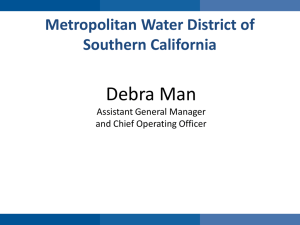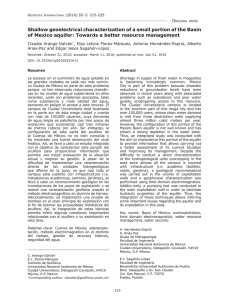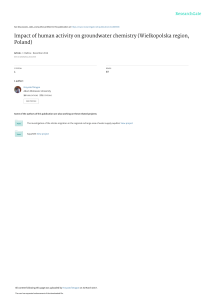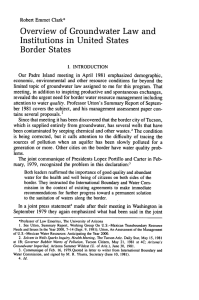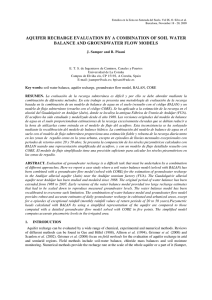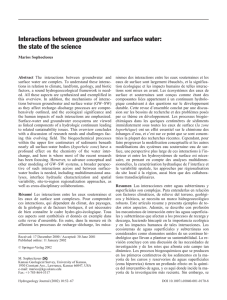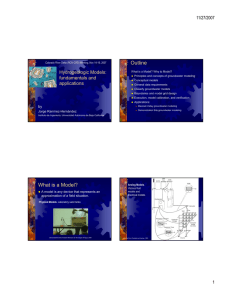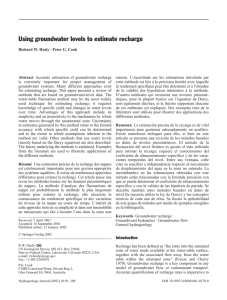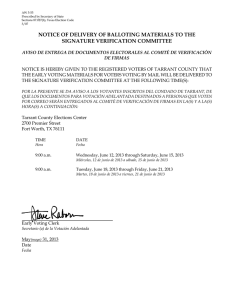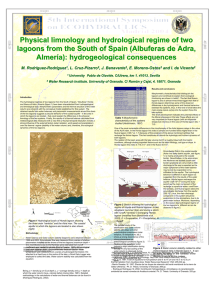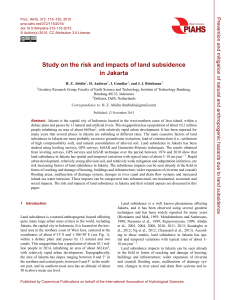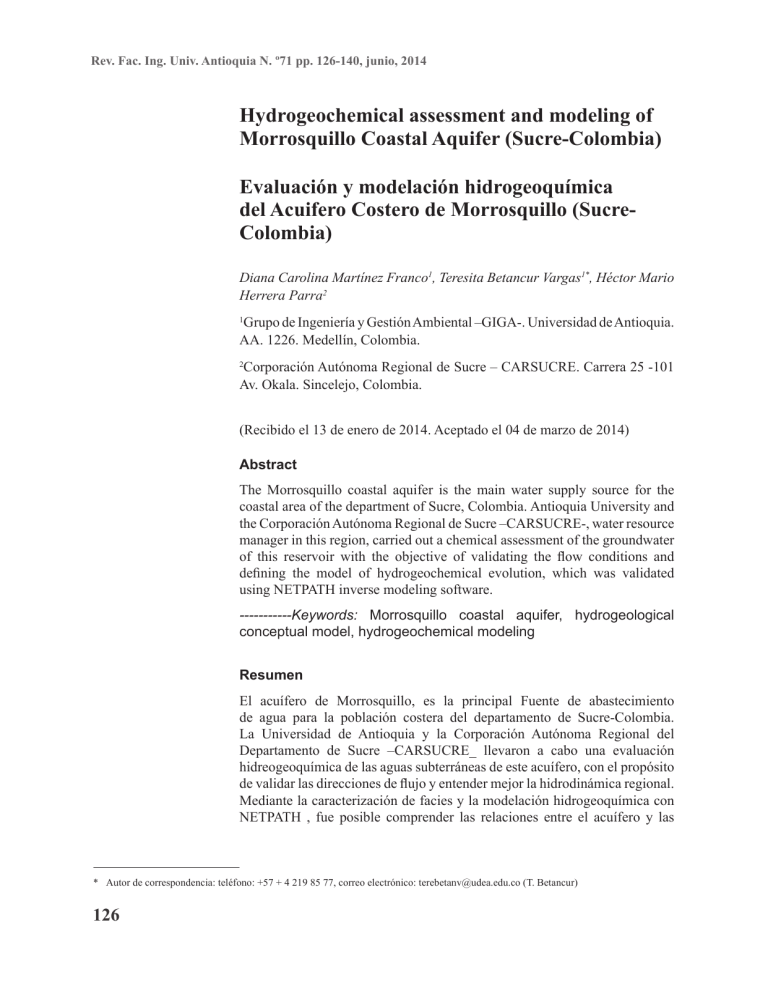
Rev. Fac. Ing. Univ. Antioquia N. º71 pp. 126-140, junio, 2014 Hydrogeochemical assessment and modeling of Morrosquillo Coastal Aquifer (Sucre-Colombia) Evaluación y modelación hidrogeoquímica del Acuifero Costero de Morrosquillo (SucreColombia) Diana Carolina Martínez Franco1, Teresita Betancur Vargas1*, Héctor Mario Herrera Parra2 Grupo de Ingeniería y Gestión Ambiental –GIGA-. Universidad de Antioquia. AA. 1226. Medellín, Colombia. 1 Corporación Autónoma Regional de Sucre – CARSUCRE. Carrera 25 -101 Av. Okala. Sincelejo, Colombia. 2 (Recibido el 13 de enero de 2014. Aceptado el 04 de marzo de 2014) Abstract The Morrosquillo coastal aquifer is the main water supply source for the coastal area of the department of Sucre, Colombia. Antioquia University and the Corporación Autónoma Regional de Sucre –CARSUCRE-, water resource manager in this region, carried out a chemical assessment of the groundwater of this reservoir with the objective of validating the flow conditions and defining the model of hydrogeochemical evolution, which was validated using NETPATH inverse modeling software. -----------Keywords: Morrosquillo coastal aquifer, hydrogeological conceptual model, hydrogeochemical modeling Resumen El acuífero de Morrosquillo, es la principal Fuente de abastecimiento de agua para la población costera del departamento de Sucre-Colombia. La Universidad de Antioquia y la Corporación Autónoma Regional del Departamento de Sucre –CARSUCRE_ llevaron a cabo una evaluación hidreogeoquímica de las aguas subterráneas de este acuífero, con el propósito de validar las direcciones de flujo y entender mejor la hidrodinámica regional. Mediante la caracterización de facies y la modelación hidrogeoquímica con NETPATH , fue posible comprender las relaciones entre el acuífero y las * Autor de correspondencia: teléfono: +57 + 4 219 85 77, correo electrónico: terebetanv@udea.edu.co (T. Betancur) 126 Hydrogeochemical assessment and modeling of Morrosquillo Coastal Aquifer (Sucre-Colombia) rocas encajantes y la diferenciación en tiempos que se dan según movimiento del agua a través de zonas mas o menos permeables. ----------Palabras clave: Acuífero costero de Morrosquillo, modelo hidrogeológico conceptual, modelación hidrogeoquímica Introduction The Morrosquillo aquifer is the main source of water for human consumption and for the development of economic activities in the coastal area of the department of Sucre, Colombia. It is located in the coastal plain of the Gulf of Morrosquillo, a region characterized by an extensive area of hills and plains that slopes slightly slope towards the sea [1]. It spans the municipalities of San Antonio de Palmito, Santiago de Tolu, San Onofre, and Toluviejo Coveñas, municipalities where the main economic activities are tourism, livestock and fishing. The climate is typically tropical, with influence from the northeastern trade winds. It is monomodal in terms of rainfall, with rainfall occurring between April and November and a dry period from December to late March. The area’s average temperature is 28 ºC and average, annual precipitation changes spatially from West to East between 1000 and 2000 mm. From north to south, the main basins of the Morrosquillo are as follows: Tumba Frailes, Trementino wetland, La Leche wetland, Guainí, Pechelín, La Perdiz, La Verde, La Caimanera wetland, Amansaguapo and finally, Remanganaguas. The Morrosquillo aquifer is an unconfined aquifer; it has an area of 700 Km2. It is composed by littoral and fluvial sediments, deposited in coast and paleostreams (Qal), they have fine sands with quartz, gravels; some layers with clay are presents. The El Carmen Formation (Pgc) and the San Cayetano Formation (Pgsc) are from Tertiary and they are in the bottom of the Quaternary sediments. The Toluviejo Formation (Pgt) is located at east in the Maria Mountains. The María Mountainsi are affected on NE direction by tectonic faults (Palmito, Guaimi y Toluviejo), and by folds (figure 1). Figure 1 Location and geological framework of the area of study 127 Rev. Fac. Ing. Univ. Antioquia N.° 71. junio 2014 The Carmen Formation is formed of gray claystones and siltstones with microfaunae. Thin layers of sandstone are present. The San Cayetano Formation has sandstones, limestones, and claystones with chert; in the upper San Cayetano Formation there are limestones and conglomerates. The Toluviejo Formation is an anticline formed of limestone and a quartz conglomerate; it has sandstones in the middle and upper parts. The Morrosquillo sediments have thicknesses between 20 and 100 m. These sediments are thicker (60 to 100 m) in the center of the study area and they have a minimum thickness of 20 m in the north. To the northwest of Tolú, near Trementino wetland, there is a paleochannel with a thickness between 30 and 80 m. To the southeast of Tolú, the Pechelin paleochannel is more than 60 m thick (Figure 2). Figure 2 Thickness map of quaternary deposits Coastal aquifers have certain peculiarities that have significant effects on its hydrodynamic pattern, in the methodologies for groundwater extraction, in potential contamination risks and in the precautions to be taken for its preservation [2]. Coastal aquifers interact with the sea, which is a constant potential limit. They usually receive a lateral flow. Groundwater flow in the horizontal plane is perpendicular to the coastline and water use need is usually high, resulting in declining groundwater levels. Hydrogeochemistry is one of the techniques used in hydrogeology in order to provide a 128 more accurate representation of a hydrogeologic system. Advances in hydrogeochemistry include the development of the concept of hydrochemical facies, the application of equilibrium theory, the investigation of oxidation-reduction processes and radiocarbon dating. These hydrochemical concepts, tools and techniques have helped to clarify the mechanisms involved in flow and transport in groundwater systems and have facilitated the work of deciphering an archive of paleoenvironmental information. Hydrochemical and isotopic information can be used to interpret the origin and method of groundwater recharge, decipher reactive processes associated with Hydrogeochemical assessment and modeling of Morrosquillo Coastal Aquifer (Sucre-Colombia) water-rock interaction, provide paleohydrological information and calibrate models of flow for in groundwater systems [3]. The use of hydrogeochemical techniques is based on the idea that the composition of groundwater is the result of the combination of the chemical characteristics of the water which enters the aquifer from rain or surface sources and the reactions that occur with the environment while the water moves through the soil and during its movement through the materials of the aquifer [4]. A hydrochemical model is a theoretical or conceptual construct that encompasses all (physically and thermodynamically consistent) chemical reactions that occur in an aquifer and that are responsible for the observed composition of the groundwater [4]. Previous studies of the Morrosquillo aquifer have indicated problems with intensive extraction, saltwater intrusion, contamination from dumping of household products and use of pesticides and fertilizers. The following hypothesis was proposed to understand the processes on the Morrosquillo aquifer: The chemical composition of the groundwater in Morrosquillo aquifer changes gradually from East to West, and this change is caused by the interaction of the groundwater with the lithological formations and sea water. The main objective of this paper is to evaluate the chemical composition of the groundwater to validate the conceptual hydrogeologic model and to define a chemical model of evolution of the groundwater Hydrogeochemical evaluation and chemical modeling of the Morrosquillo coastal aquifer was conducted by –CARSUCRE- and the University of Antioquia, achieving an understanding of the chemical evolution of the groundwater and the relationship it has with flow conditions arising from the conceptual model of the system. The knowledge derived from this study serves as a tool for management of the groundwater by appropriate environmental authorities. Methodology Hydrogeologic conceptual model The conceptual model was obtained by processing the existing geological, geophysical, hydrological and hydrogeological information. Spatial management and interpretation of the data was done using ArcGIS software. The geometry of the aquifer was defined from the analysis of 158 vertical electrical soundings presented in the geological geophysical model of the Gulf of Morrosquillo [5] and its correlation with stratigraphic columns obtained by drilling. Thickness of the Quaternary deposits was spatially interpolated by using the Kriging interpolation method. The groundwater flow distribution was constructed from data collected in 49 piezometric and topographic level surveys [6] using a local polynomial interpolation method [7, 8]. The amounts of recharge were taken from the results of the mass balance achieved in the report of the hydrogeological map of Sucre and the environmental diagnosis of the coastal aquifer of the Gulf of Morrosquillo shore zone Tolu - Coveñas [1, 9]. The conceptual model will be presented in part 3.1 of this paper. Monitoring network The conceptual model and the criteria outlined in the scientific literature were brought together to design a hydrogeochemical monitoring network consisting of 24 sampling wells, 4 surface sampling points , 2 sampling points in the springs of Toluviejo, a rainwater sample and a seawater sample. The selected wells meet some of the following conditions: i) they were located to ensure between 3 and 5 samples over 6 sections of flow (Figure 3); ii) depth wells were used, and wells with filters at various depths were avoided; iii) multipiezometers was included; iv) the sampling points could show a possible lateral flow from the Toluviejo formation, for which 129 Rev. Fac. Ing. Univ. Antioquia N.° 71. junio 2014 two springs were sampled there; v) a relationship could exist between groundwater and surface water (4 samples were taken in 2 of the main surface currents). Two sampling expeditions were made, one in the rainy season (October 2008) and one in the dry season (March 2009). Every sample point is identified by an alphanumeric code. The letters allow identifying if the checkpoints are for groundwater (GW), spring water (MAN) or surface water (SUP). The three digits correspond to the number of the section or line of flow (the first) and to the checkpoint’s position in line, following the direction of groundwater flow (the final two digits) (figure 3). Samples were taken to assess: chloride, sulfate, carbonate, bicarbonate, nitrate, nitrite, phosphate, sodium, potassium, magnesium, calcium, iron, arsenic, silica, total hardness, total dissolved solids (TDS) and alkalinity. Chemical analyses were carried out at the Laboratory of Environmental Quality CORANTIOQUIA, certified by IDEAM, following the methods provided in [10]. The pH, conductivity, temperature and redox potential were measured in the field using calibrated and certified equipment. All sampling was done following procedures outlined in the protocols of the International Atomic Energy Agency-IAEA- [11] and the Institute of Hydrology, Meteorology and Environmental Studies of Colombia IDEAM [6]. The samples were analyzed in a certified laboratory using standard methods. Hydrogeochemical model An exploratory computation analysis was conducted and the ion balance of the data was assessed; an error rate less than 10% was considered acceptable. Spatial distribution Maps of TDS, conductivity and chlorides were made. Piper, Stiff, and Schoeller diagrams were drawn by using the commercial software AquaChem 4.0 created by Waterloo [4, 12, 13], which allowed characterization of hydrogeochemical facies [14] and observation of the variation in chemical composition between each section of flow. Some ion ratios were analyzed that provided insights into the history of the groundwater and the situation in regards to seawater intrusion [15, 16]. Figure 3 Monitoring network, water table and flow lines 130 Using the results obtained from these tests and the conditions of the hydrogeological conceptual model, a hydrogeochemical model was made which was then validated by reverse chemical modeling using the program NETPATH, which is a free software from the U.S. Geological Service that allows interpretation of geochemical reactions of mass balance between an initial and final sample along a flow line and calculation of the mix ratio in a sample of known composition, using from two to five water samples [17]. Hydrogeochemical assessment and modeling of Morrosquillo Coastal Aquifer (Sucre-Colombia) Results and discussion the sea-shore. Towards the northern and central ends of the coast, groundwater levels are below sea level (-1.5 meters according with data field), which indicates the presence of hydraulic gradients that allow seawater intrusion to take place. The presence of paleo-channels in the region, such as that of the river Pechelín, could cause special textural characteristics in paleosediments, causing high lateral velocity and some areas of preferential flow. Hydraulic conductivity varies between 0.2 and 25 meters per day, the transmisivity varies between 7.5 y 200 m2/day. The places with higher conductivity are associated with palaeochannels. Using mass balance, a precipitation recharge of 282 mm/ year was calculated for the Morrosquillo aquifer, plus the flow system suggests the existence of a lateral flow from the Toluviejo Formation in the foothills of Montes de Maria [9]. Hydrogeologic conceptual model The Morrosquillo aquifer corresponds to a geologic unit made up of Quaternary deposits of fluvial and marine alluvium origin (Qal) which come from the sea and the river, respectively consisting of fine quartz sands, gravels and pebbles with intercalations of clay that unevenly overlay the Tertiary formations Carmen (Pgc) and San Cayetano (Pgsc), which constitute the basement. Towards the east in the direction of the Maria Mountains, these deposits are bordered by the limestone formation Toluviejo (Pgt). Structurally, there is evidence of tectonic activity that has caused folding and faulting in the rocks of the region (Figure 1). Standouts include the Toluviejo anticline and the longitudinal faults of Palmito, Guaimí and Toluviejo [1]. 3.2. Hydrogeochemical characterization The Hydrochemical data obtained with their ion balance calculation are shown on Table 1. From a statistical point of view, hydrogeochemically, the dry season and wet season (tables 2 and 3) did not vary significantly. Correlations greater than 0.8 exist between sodium and chloride and sodium and bicarbonate, and correlations between 0.75 and 0.8 exist between potassium, sodium, chloride, bicarbonate and sulfate. These results may be explained in part by dissolution of minerals like calcite, halite and gypsum. The size of the aquifer is similar to that of recent sedimentary deposits (700 km2), and its thickness varies between 20 and 100 meters (Figure 2). In general, the aquifer behaves like an unconfined aquifer, but the distribution of clay lenses gives to the hydrogeological system characteristics of a multilayer aquifer, especially in the area near the coast. As shown by the piezometric surface in Figure 3, groundwater flows perpendicularly towards Fe2+ mg/l Clmg/l HCO3mg/l CO3mg/l NO3mg/l Ion balance Mg2+ mg/l 4.73 115.00 125.00 262.00 60.20 228.00 6.51 0.83 1.94 3.63 0.16 0.98 4.77 58.90 82.80 21.20 90.40 46.90 0.14 44.90 62.70 11.10 22.00 31.20 0.03 0.18 0.06 0.09 0.06 0.17 0.75 89.20 173.00 77.30 20.00 87.80 36.00 406.00 510.00 622.00 451.00 612.00 0.00 0.00 0.00 0.00 0.00 0.00 0.75 1.50 1.54 -5.72 0.75 124.00 23.30 -0.63 0.75 121.00 17.00 -3.38 0.75 13.80 9.00 2.70 0.75 33.90 17.90 1.30 0.75 87.40 22.60 1.62 SiO mg/l2 Ca2+ mg/l 6.88 6.78 6.72 7.49 6.82 7.34 SO42mg/l K+ mg/l W W W W W W Na+ mg/l ALL GW-101 GW-102 GW-103 GW-201 GW-202 pH Código Table 1 Hydrochemical analysis for dry season (March 2009) and rain season (October 2008) Continue 131 Rev. Fac. Ing. Univ. Antioquia N.° 71. junio 2014 K+ mg/l Ca2+ mg/l Mg2+ mg/l Fe2+ mg/l Clmg/l HCO3mg/l CO3mg/l NO3mg/l SO42mg/l SiO mg/l2 Ion balance W W W W W W W W W W W W W W W W W W W W W W D D D D D D D D D D D D D D D Na+ mg/l GW-203 GW-301 GW-302 GW-303 GW-401 GW-402 GW-403 GW-404 GW-405 GW-501 GW-502 GW-503 GW-504 GW-601 GW-602 GW-603 GW-700 Man-01 SUP-11 SUP-12 SUP-21 SUP-22 GW-101 GW-103 GW-203 GW-301 GW-303 GW-401 GW-402 GW-403 GW-404 GW-405 GW-501 GW-502 GW-503 GW-504 GW-602 pH Código Table 1 Continued 7.25 6.26 7.05 6.66 7.01 7.00 7.00 7.32 7.24 7.42 6.90 7.36 7.17 8.87 6.91 6.75 6.90 7.14 7.30 6.90 7.52 8.04 6.75 7.87 7.63 6.95 7.10 7.08 6.80 7.20 7.61 7.45 7.20 7.00 7.54 7.44 7.04 337.00 14.90 217.00 212.00 47.40 197.00 102.00 838.00 264.00 87.50 61.30 59.70 86.80 150.00 119.00 64.70 205.00 8.99 35.00 16.60 104.00 61.80 64.80 224.00 354.00 14.00 188.00 37.50 187.00 93.00 730.00 234.00 78.30 52.70 59.90 87.20 104.00 5.98 0.58 0.38 1.00 0.25 1.90 2.24 23.20 3.64 6.91 4.53 5.80 2.08 11.40 3.17 3.83 2.54 0.64 4.26 4.45 7.78 9.79 1.03 4.03 7.04 3.91 1.45 0.47 1.98 2.27 17.00 11.70 5.95 4.24 8.35 4.27 3.00 47.50 61.10 75.40 60.50 57.90 196.00 95.60 25.40 112.00 99.30 125.00 81.20 113.00 269.00 106.00 77.50 43.60 103.00 85.80 21.00 116.00 87.60 58.40 21.30 62.90 57.60 72.60 65.50 206.00 134.00 27.10 193.00 114.00 130.00 86.10 115.00 111.00 24.50 10.20 46.50 37.90 30.50 60.00 27.30 21.60 39.00 18.50 23.40 17.60 29.50 11.50 24.30 14.50 15.70 2.63 23.60 6.93 26.70 19.30 38.00 9.88 27.40 9.99 29.20 27.70 58.60 30.20 21.90 38.30 16.80 22.50 14.80 26.40 24.50 0.03 0.07 0.03 0.03 0.03 0.03 0.03 0.03 0.03 0.03 0.03 0.03 0.03 0.03 0.03 0.03 0.07 0.03 0.08 0.43 0.09 0.27 0.03 0.21 0.03 0.16 0.03 0.03 0.03 0.20 0.03 0.08 0.03 0.03 0.03 0.03 0.03 239.00 9.53 41.00 102.00 31.20 200.00 78.80 492.00 183.00 52.80 76.80 26.00 59.00 350.00 90.10 60.80 74.20 19.30 15.10 14.80 113.00 74.80 79.60 78.40 312.00 10.40 103.00 34.50 339.00 135.00 492.00 156.00 66.50 72.30 26.80 57.50 91.00 655.00 248.00 729.00 593.00 307.00 511.00 526.00 864.00 456.00 401.00 478.00 372.00 531.00 124.00 496.00 216.00 458.00 304.00 271.00 113.00 294.00 235.00 359.00 623.00 606.00 236.00 588.00 292.00 506.00 508.00 870.00 453.00 409.00 475.00 373.00 526.00 480.00 0.00 0.00 0.00 0.00 0.00 0.00 0.00 0.00 0.00 0.00 0.00 0.00 0.00 7.92 0.00 0.00 15.70 0.00 0.00 0.00 0.00 0.00 0.00 0.00 0.00 0.00 0.00 0.00 0.00 0.00 0.00 0.00 0.00 0.00 0.00 0.00 0.00 0.75 0.75 0.75 0.75 2.55 0.75 0.75 1.73 0.75 0.75 0.75 0.75 0.75 0.75 0.75 0.75 0.75 2.03 0.75 0.75 0.75 0.75 ND ND ND ND ND ND ND ND ND ND ND ND ND ND ND 76.80 12.80 75.50 81.40 52.60 239.00 51.80 377.00 300.00 93.80 48.20 56.40 77.90 466.00 78.70 70.60 92.70 9.93 183.00 1.50 197.00 156.00 50.40 11.70 69.10 19.09 85.90 38.10 270.00 75.80 377.00 318.00 79.40 49.40 51.20 67.70 79.90 14.70 20.50 17.60 17.20 19.30 21.10 22.70 18.90 19.00 15.30 23.00 24.00 21.80 9.77 24.00 24.00 22.20 5.85 10.50 9.50 9.99 10.20 21.20 8.08 12.70 17.60 15.50 18.90 19.10 21.10 15.80 16.60 13.10 18.70 19.90 18.40 21.80 0.18 -1.11 7.26 3.50 1.88 10.12 -1.98 5.25 3.55 1.89 -0.53 1.14 -0.62 -1.71 0.73 8.09 1.40 -1.00 -5.28 1.97 2.16 -2.06 -1.90 -3.89 1.91 -0.53 -0.50 4.25 -0.43 -1.78 -0.92 11.51 1.65 -0.77 2.37 0.63 0.02 Continue 132 Hydrogeochemical assessment and modeling of Morrosquillo Coastal Aquifer (Sucre-Colombia) GW-603 GW-800 Man-01 Man-02 Mar SUP-11 Sup-12 Sup-21 Sup-22 D D D D D D D D D 7.49 124.00 8.09 86.60 14.70 0.08 66.50 431.00 0.00 7.31 1642.00 33.00 149.00 80.40 0.14 1500.00 831.00 0.00 7.02 9.52 0.65 107.00 2.68 0.27 19.40 307.00 0.00 6.80 22.70 0.84 206.00 11.60 0.03 57.90 421.00 0.00 8.56 11391.00 342.00 373.00 1099.00 0.03 17240.00 126.00 0.00 8.34 31.90 3.33 84.60 16.00 0.03 9.32 313.00 3.40 8.00 103.00 6.84 114.00 37.30 0.03 95.60 484.00 0.00 8.00 139.00 14.20 180.00 37.60 0.03 166.00 521.00 0.00 8.00 124.00 11.90 179.00 39.00 0.03 148.00 558.00 0.01 Ion balance SiO mg/l2 SO42mg/l NO3mg/l CO3mg/l HCO3mg/l Clmg/l Fe2+ mg/l Mg2+ mg/l Ca2+ mg/l K+ mg/l Na+ mg/l pH Código Table 1 Continued ND 75.80 22.10 2.79 ND 449.00 16.80 13.87 ND 10.00 4.37 1.35 ND 57.70 4.68 11.15 ND 2276.00 0.00 6.75 ND 79.90 11.50 -1.48 ND 116.00 9.79 1.20 ND 247.00 11.80 0.19 ND 208.00 8.46 0.39 D: Dry season, W: Wet season, ND: Results were considered unacceptable because wron laboratory analysis were found. Table 2 Statistics for wet season Count Average Standard Dev. Coef. Of Var. Minimum Maximum Range Ca Mg K Na Cl HCO3 SO4 SiO2 pH TDS 17 84.77 41.98 0.50 21.20 196.00 174.80 17 25.73 14.06 0.55 2.63 60.00 57.37 17 4.13 5.32 1.29 0.25 23.20 22.95 17 169.25 196.53 1.16 8.99 838.00 829.01 17 110.99 117.203 1.06 9.53 492.00 482.47 17 469.77 162.70 0.35 216.00 864.00 648.00 17 103.81 103.50 1.00 9.93 377.00 367.07 17 19.04 5.28 0.28 5.85 24.00 18.15 17 7.04 0.31 0.04 6.26 7.49 1.23 17 777.882 457.904 0.59 292 2168 1876 Table 3 Statistics for dry season Count Average Standard Dev. Coef. Of Var. Minimum Maximum Range Ca 17.00 96.95 50.68 0.52 21.30 206.00 184.70 Mg 17.00 24.33 13.16 0.54 2.68 58.60 55.92 K 17.00 5.03 4.38 0.87 0.47 17.00 16.53 Na 17.00 155.41 173.88 1.12 9.52 730.00 720.48 According to the spatial distribution of data from total dissolved solids and chloride (figure 4), in the north (flow sections 1.2 and 3), the water is less mineralized towards the east and has a higher concentration of salts in points near the coast. This can be explained by the incorporation Cl 17.00 125.88 131.97 1.05 10.40 492.00 481.60 HCO3 17.00 473.06 150.40 0.32 236.00 870.0 634.00 SO4 17.00 101.68 109.25 1.07 10.00 377.00 367.00 SiO2 17.00 16.76 4.88 0.29 4.37 22.0 17.73 pH 17.00 7.25 0.32 0.04 6.75 7.87 1.12 STD 17.00 895.06 482.56 0.54 370.00 2150.0 1780.00 of new solutes which occurs because the water flows through a solid media. Possible mixing with fresh waters from the Pechelín paleochannel or a direct local recharge source can be deduced from the decrease in concentration of these two parameters between the points GW-402 and GW- 133 Rev. Fac. Ing. Univ. Antioquia N.° 71. junio 2014 403. TDS and Chloride concentrations found on GW-404 were different to those on GW-405. Both wells are located in the same place near the shore, but the water is taken from different depths. Higher concentrations were discovered on the more superficial piezometer; on this sampling point, groundwater analysis show different hydrogeochemical facies. This is evidence of their existing multilayer aquifer conditions. In sections 5 and 6, there was no significant change, which can be explained by the rapid flow through the Pechelín paleochannel. The point GW-601 (at east, next to de limit between the aquifer and Maria Mountains) sampled during the wet season appears to be receiving water from the Toluviejo Formation. Figure 4 Spatial distribution of total dissolved solids and chloride (mg/l) Characterization of facies and ionic ratios Figure 5 contains four sampling groups for groundwater. Group 1 contains samples with lower chemical evolution that have calcium bicarbonate and mixed bicarbonate facies and electrical conductivity between 500 and 1100 ms/cm. Group 2 is characterized by mixed facies with electrical conductivity between 1500 and 2200 ms/cm in the dry season. Groundwaters 134 with high degrees of chemical evolution, sodium bicarbonate facies and electrical conductivity between 1000 and 2000 ms/cm make up group 3. In group 4, sodium chloride composition and electrical conductivity levels between 2000 and 6300 ms/cm may indicate contamination by seawater intrusion. Figure 5 also shows that no significant difference exists between the chemical composition of the samples in the dry and rainy seasons. Hydrogeochemical assessment and modeling of Morrosquillo Coastal Aquifer (Sucre-Colombia) Figure 5 Grouping of samples using Piper diagrams Figure 6 contains, Piper diagrams, distribution of hydrogeochemical facies by depth, average electrical conductivity and some stratigraphic information taken from [5] and from existing stratigraphic columns for some flow sections. Additionally, in Figure 7 there is a map with Stiff diagrams for easy visualization of the facies and the evolution of the water in the direction of flow. In the northern area of study, sections 1, 2 and 3, the nature of the evolution is very clear in regard to facies, the bicarbonate calcium and mixed bicarbonate facies having changed to bicarbonate sodium and chloride ones. In the center (Section 4), there is evidence of possible mixture with fresher waters, which is shown primarily by the decrease in concentration of totally dissolved solids and chlorides and by the sequence of chloride facies between points GW-402 and GW-403. Section 5, which is associated with the paleochannel of the Pechelín River, chemical composition shows no sign of evolution, which could be due to a relatively fast current. Section 6 is the same, except for point GW-601, which has a different chemical composition, as stated above. Chemical evidence of saltwater intrusion processes were observed only in points GW-800 and GW-203; this processes are a local condition, and it occurs in sites were the groundwater has intensive used. 135 Rev. Fac. Ing. Univ. Antioquia N.° 71. junio 2014 Figure 6 Piper diagrams and profiles of facies 136 Hydrogeochemical assessment and modeling of Morrosquillo Coastal Aquifer (Sucre-Colombia) Figure 7 Distribution of facies using Stiff diagrams According to figure 8, the relations rNa/rCl and rSO4/rCl have values greater than the line of sea water, which is evidence of other sources of sodium, probably ion exchange, and possibly the dissolution of gypsum as a source of sulfates. The relation HCO3/Cl shows values that are normal for inland waters. In general, as already noted, although there is evidence that at some points contact exists with the sea, seawater intrusion is not the predominant process in the aquifer, and in general, this type of contamination occur only next to GW-800 and GW-203. Figure 8 Ionic ratios 137 Rev. Fac. Ing. Univ. Antioquia N.° 71. junio 2014 Hydrogeochemical modeling Inverse hydrogeochemical modeling was performed using NETPATH, with each model being supported by a Schoeller diagram to determine which phases (chemical processes) and which constraints (chemical compounds) should be included. The proposed hydrogeochemical conceptual model considers the following as possible processes for the evolution of water: cation exchange of calcium for sodium or magnesium for sodium due to the presence of clay lenses; dissolution of halite and gypsum, minerals normally found in coastal sedimentary environments; reverse cationic exchange induced by local seawater intrusion; dissolution of calcite, which would come from the remains of calcareous shells or from possible lateral flow from the Toluviejo aquifer; mixture with seawater from seawater intrusion (in GW-800 and GW-203) and with fresh water from recharge points; possible interactions with common clay formed from feldspars such as albite; Analysis of aluminum was not performed, but it is possible its presence because clays have Al. a form of representative modeling was chosen through which chemical processes could be validated. Figure 9 shows the results. Table 3 shows the mass transfer coefficients for each phase of the NETPATH (processes) used. These refer to the moles of each element involved in the reaction. A negative sign indicates removal of the element from the solution; this must be multiplied by the sign obtained in the model. Table 3 NetPath transfer coefficients (moles) Phase Ca2+ Mg2+ Na+ SO4- Cl- HCO3- Al2+ CaCO3 (calcite) 1 1 CaSO4 (gypsum) 1 1 NaCl (halite) 1 1 Albite 1 1 Int. Ca/Na -1 2 Int. Mg/Na -1 2 CO2 Gas 1 As stated in the hydrogeochemical characterization, three areas in the aquifer were identified that had different conditions of evolution. For each one, 138 Figure 9 Schoeller diagrams and results of inverse modeling (moles) In the model of flow section 2 (Figure 9), an increase in concentrations of bicarbonate, sulfate, chloride, sodium, and magnesium is observed, while calcium concentration decreased between points GW-201 and GW-202. For this Hydrogeochemical assessment and modeling of Morrosquillo Coastal Aquifer (Sucre-Colombia) reason, processes of dissolution of calcite, gypsum, halite and albite were considered, along with ionic exchange of calcium for sodium. Between the points GW-202 and GW203, calcium and bicarbonate concentrations did not vary significantly. There was a decrease in magnesium accompanied by an increase in sodium and chloride, while sulfate remained constant. Processes of dissolution of calcite and halite, as well as processes of exchange of magnesium for sodium were taken into account because, following the results of the modeling, these processes could explain the chemical evolution of the water in this sector. However, the increase in the content of Na and Cl while sulfate remains constant should also reflects a sea-water encroachment. In the modeling of mixture with direct local recharge water between points GW-402 and GW403, it can be seen (Figure 9) that the chemical composition of these deposits is very similar, and it is possible that the decrease in mineralization is due mainly to mixture with fresh water. It was proposed that during the circulation of water, rain dissolves CO2 in the unsaturated zone, and along the way from GW-402 to GW-403, reactions such as dissolution of halite and calcite and ion exchange occur. These reactions could be expected based on the results of modeling, a higher proportion of groundwater flow in the mixture was found. To evaluate the model of seawater intrusion in GW-404 and GW-800, GW-403 was taken as a starting point (water without contamination by groundwater intrusion). Mixture with seawater and processes of dissolution of calcite and gypsum and ionic exchange of calcium and magnesium for sodium were considered, all of which could occur between GW-403 and points GW-404 and GW-800. The resulting model shows, as expected from the characterization, a higher percentage of sea water contamination at point GW-800, which is closer to the coast. Because there was no significant evolution in flow section 6, NETPATH modeling was not performed. Conclusions The Morrosquillo aquifer corresponds to a geologic unit made up of Quaternary deposits of fluvial and marine alluvium origin (Qal). Towards the east in the direction of the Maria Mountains, these deposits are bordered by the limestone formation Toluviejo (Pgt). Structurally, there is evidence of tectonic activity. In general, the aquifer behaves like an unconfined aquifer, but the distribution of clay lenses gives to the hydrogeological system characteristics of a multilayer aquifer, especially in the area near the coast. Groundwater flows perpendicularly towards the sea-shore. Towards the northern and central ends of the coast, groundwater levels are below sea level (-1.5 meters according with data field), which indicates the presence of hydraulic gradients that allow seawater intrusion to take place. The presence of paleochannels in the region, such as that of the river Pechelín, could cause special textural characteristics in paleosediments, causing high lateral velocity and some areas of preferential flow. According to the spatial distribution of data from total dissolved solids and chloride, in the north, the water is less mineralized towards the east and has a higher concentration of salts in points near the coast. Possible mixing with fresh waters from the Pechelín paleochannel or a direct local recharge source can be deduced from the decrease in concentration of total dissolved solids and chloride. Chemical evidence of saltwater intrusion processes were observed only in two points; this processes are a local condition, and it occurs in sites were the groundwater has intensive used; relations rNa/rCl and rSO4/rCl have values greater than the line of sea water, which is evidence of other sources of sodium, probably ion exchange, and possibly the dissolution of gypsum as a source of sulfates The proposed hydrogeochemical model and the modeling done with NETPATH validate the hydrogeological conceptual model of Morrosquillo aquifer in reference to the direction of flow inferred from piezometry. According to 139 Rev. Fac. Ing. Univ. Antioquia N.° 71. junio 2014 results, chemical evolution in the groundwater of Morrosquillo aquifer is due mainly to processes of ionic exchange, dissolution of calcite and gypsum, and to a lesser degree, contribution of ions from halite and feldspars. In relation to these processes, ionic ratios indicate that saltwater intrusion is not a dominant factor in the chemical evolution of the groundwater. However, it was found that saltwater intrusion may affect the quality of water in the wells that are closest to the beach. There was evidence that chemical characteristics may differ by depth, there being both local and regional flows which are also influenced by confinement in some places due to the presence of clay lenses of considerable thickness. Because rain is an input to the system, it is necessary to monitor it both chemically and isotopically in order to quantify the proportions of local and distant recharge feeding the aquifer; it is also necessary to make new hydrogeochemical sampling expeditions to clarify whether or not the groundwater of the aquifer really shows little variation from one hydrological stage to another, and to therefore know if distant recharge, slow flow rates and periods of long residence are taking place. In the short term, a sampling during the phase transition from summer to winter could shed important light on the subject, enabling a clearer quantification of the processes of mixture taking place. Acknowledgements This research was supported by CARSUCRE and the University of Antioquia. This paper benefited greatly the contributions of Diana Santa. References 1. INGEOMINAS. Groundwater map, Sucre departamento, Colombia. Informe interno. Bogotá, Colombia 2002. pp. 120. 2. E. Karro, A. Marandi, R. Vaikm. “The Origin of Increased Salinity in the Cambrian-Vendian Aquifer System on the Kopli Peninsula, Northern Estonia”. Hydrogeology Journal. Vol. 12. 2004. pp. 424-435. 140 3. P. Glynn, L. Plummer. “Geochemistry and the Understanding of Ground-water Systems”. Hydrogeology Journal. Vol. 13. 2005. pp 263-287. 4. C. Appelo, D. Postman. Geochemistry Groundwater and Pollution. 4th ed. Ed. A.A Balkema. Rotterdam, Netherlands. 2005. pp. 533. 5. V. Franco. Geology and geophisic model of the Morrosquillo Gulf. Informe interno. INGEOMINAS. Bogotá, Colombia. 1999. 6. IDEAM. Guide for Veriments at Surface Water and Groundwater. Ed. Imprenta Nacional. Bogotá, Colombia. 2006. pp. 83. 7. ESRI. User Manual of ArcGIS. ESRI edition. 2008. pp. 325. 8. H. Apaydin, F. Kemad, Y. Ersoy. “Spatial Interpolation Techniques for Climate Data in the GAP Region in Turkey”. Climate Research. Vol. 28. 2004. pp 31-40. 9. G. Gutierrez. Environemntal diagnostic of the Morrosquillo aquifer: Litoral zone Tolú – Coveñas. Informe interno. Universidad Nacional de Colombia. Bogotá, Colombia. 2004. pp. 45. 10. A. Eaton, L. Clesceri, E. Rice, A. Greenberg. Standard Methods for the Examination of Water and Wastewater. APHA-AWWA. Baltimore, USA. 2005. 11. L. Araguas, P. Aggarwal. Introduction to Water Sampling and Analysis Dor Isotope Hydrology. IAEA. 2007. 12. J. Hem. Study and Interpretation of the Chemical Characteristics of Natural Waters. USGS WaterSupply Papers. WSP 2254. 1992. pp. 263. 13. E. Custodio, R. Llamas. Underground Hydrology. 2nd ed. Ed. Omega Editores. Barcelona, España. 1996. pp. 584. 14. I. Chevotareb. “Metamorphism of Natural Waters in the Crust of Weathering”. Geochim Cosmochim. Acta. Vol. 8. 1955. pp. 22. 15. C. Patalas, I. Diamantis. “Origin and Distribution of Saline Groundwaters in the Upper Miocene Aquifer System, Coastal Rhodope Area, Northeastern Greece”. Hyidrogeology Journal. Vol. 7. 1999. pp. 305-316. 16. A. Honslow. Water Quality Data, Analysis and Interpretation. Ed. Lewis Publisher. Florida, USA. 1995. pp. 397. 17. L. Plummer, E. Prestemon, D. Parkhurst. An Interactive Code (NETPATH) for Modelling NET Geochemical Reactions Along a Flow PATH. USGS Water Resource Investigation Report. Serie 94-4169. Reston, Virginia. 1994. pp.130.
